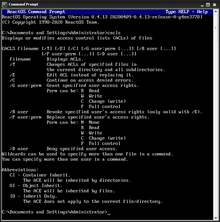cacls
 The ReactOS cacls command | |
| Developer(s) | Microsoft, Thomas Weidenmueller |
|---|---|
| Initial release | 1994, 29–30 years ago |
| Operating system | Microsoft Windows, ReactOS |
| Type | Command |
| License | Windows: Proprietary commercial software ReactOS: GNU Lesser General Public License |
| Website | docs |
The cacls.exe utility is a deprecated command line editor of directory and file security descriptors in Windows NT 3.5 and later operating systems of the Windows NT family.[3] Microsoft has produced the following newer utilities, some also subsequently deprecated, that offer enhancements to support changes introduced with version 3.0 of the NTFS filesystem:
- xcacls.exe[4][5][6][7] is supported by Windows 2000 and later and adds new features like setting Execute, Delete and Take Ownership permissions
- xcacls.vbs[8][9]
- fileacl.exe [10]
- icacls.exe (included in Windows Server 2003 SP2 and later)[11][12]
- SubInAcl.exe - Resource Kit utility to set and replace permissions on various type of objects including files, services and registry keys
- Windows PowerShell (Get-Acl[13] and Set-Acl[14] cmdlets)
The ReactOS version was developed by Thomas Weidenmueller and is licensed under the GNU Lesser General Public License.[15]